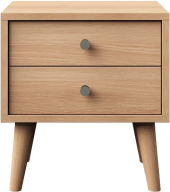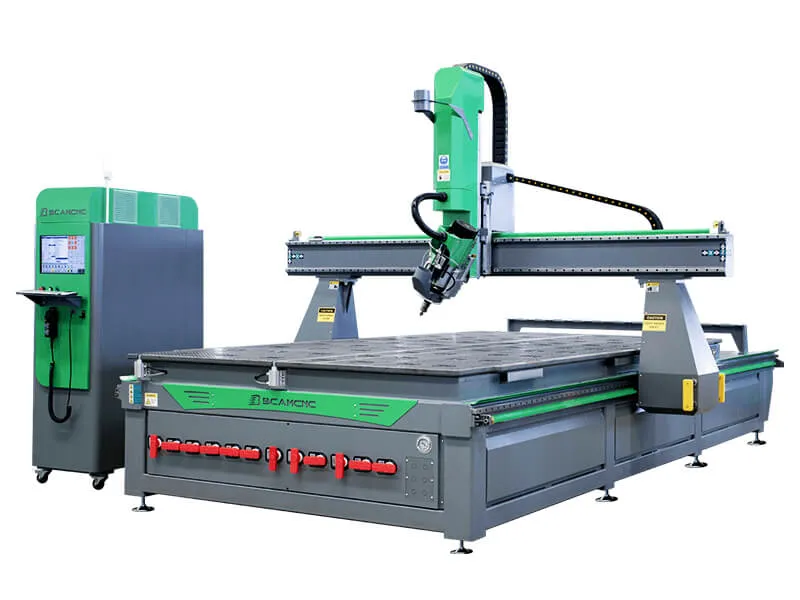Monday To Saturday
8:30 AM - 6:00 PM
Affordable & Industrial-Grade 4 Axis CNC Routers for Manufacturing and Custom Production
4 Axis CNC Routers for Cutting, and Milling on Wood, Plastics, and Metals
The 4 Axis CNC Router Machine expands the capabilities of a traditional 3 axis router by adding a rotary axis (A-axis), allowing 360° machining for cylindrical, curved, and complex 3D parts. It is widely used in woodworking, furniture making, cabinet production, signage, mold making, and metal fabrication. From solid wood, MDF, plywood, and acrylic to aluminum, plastics, and composites, the 4 axis CNC router ensures precise and efficient cutting, drilling, and milling.
With industrial-grade spindles (7.5–15HP), simultaneous 4 axis machining, and optional automatic tool changers, these machines deliver accuracy up to ±0.02mm while reducing setup time. Whether for furniture legs, stair railings, 3D sculptures, aerospace parts, or automotive prototypes, the 4 axis CNC router offers unmatched flexibility for both custom projects and mass production. Designed for high reliability and low maintenance, it provides manufacturers, workshops, and production facilities with a cost-effective solution for modern CNC machining.
$15,420.00 Original price was: $15,420.00.$13,956.50Current price is: $13,956.50.
$15,000.00 Original price was: $15,000.00.$11,700.00Current price is: $11,700.00.
Complete Guide to 4 Axis CNC Router Machines
A 4 Axis CNC Router adds a rotary axis (A, B, or C-axis) to standard 3 axis movement, enabling simultaneous 4 axis machining for cylindrical, curved, and complex 3D parts. Perfect for woodworking, furniture, cabinet making, signage, aluminum, acrylic, plastics, and metal fabrication, it delivers precise cutting, drilling, and milling. These machines enhance efficiency, reduce setup time, and support both custom projects and industrial production with high accuracy and optional automatic tool changers.

Definition of 4 Axis CNC Router Machine
A 4 Axis CNC Router Machine is an advanced computer-controlled router that adds a rotary axis (A, B, or C-axis) to the standard X-Y-Z linear axes of a 3 axis CNC router. This allows simultaneous 4 axis machining for cylindrical, curved, and complex 3D parts, enabling precise cutting, drilling, and milling. Unlike a standard 3 axis machine, a true 4 Axis CNC Router can process multi-surface 3D objects, reliefs, cylinders, and non-standard patterns in a single setup. Optional configurations include automatic tool changers and industrial-grade spindles, making it suitable for both custom projects and high-volume production.
Applications of 4 Axis CNC Router
The 4 Axis CNC Router is widely used across woodworking, metalworking, and composite fabrication industries:
• Furniture & Cabinet Making: Wooden doors, panels, office furniture, stair balusters, table legs, solid wood cabinets, and decorative cuttings.
• Woodworking & Carpentry: Relief sculpture, Pierced work, musical instruments, gaming cabinets, computer desks, and custom wood projects.
• Signage & Advertising: Acrylic and PVC cutting, logo production, signage boards, lightbox molds, and plastic decorative panels.
• Metal & Composite Fabrication: Aluminum sheets, aluminum plastic panels, honeycomb panels, copper, stainless steel, and other metal parts.
• 3D Cutting & Prototyping: Sculptures, statues, 3D architectural models, automotive and aerospace components, specialty molds, and industrial prototypes.
• Panel Processing & Specialty Materials: MDF, plywood, epoxy resin, ABS, PP, PE, artificial stone, foam, and composite sheets.
Features of 4 Axis CNC Router Machine
• 360° Rotary Axis Machining: Enables simultaneous 4 axis processing for complex cylindrical and multi-surface parts.
• High Precision & Efficiency: Achieves ±0.02mm accuracy with industrial-grade spindles (7.5–15HP).
• Automatic Tool Changer (Optional): Reduces setup time and increases production efficiency.
• Versatile Material Compatibility: Wood, MDF, plywood, acrylic, plastics, aluminum, copper, stainless steel, foam, and composites.
• Customizable CNC Controllers: Support Mach3, Mach4, OSAI, Siemens, FANUC, and other professional CNC systems.
• Advanced Programming Features: A/C code and M code support, intelligent memory function, breakpoint continuation, and parameter backup/recovery.
• Professional 3D Capability: Perfect for 3D wood, stone cuttings, furniture components, stair pillars, and complex industrial parts.
• Durable & Reliable: Strong anti-interference ability and compliance with CE and other industrial safety standards.
Specifications of 4 Axis CNC Router Machine
| Specification | Details |
|---|---|
| Brand | BCAMCNC, customizable OEM options |
| Table Sizes | 2′ x 3′, 2′ x 4′, 4′ x 4′, 4′ x 6′, 4′ x 8′, 5′ x 10′, 6′ x 12′ (customizable for industrial applications) |
| Axes | 4 Axis CNC Router |
| Capabilities | 3D Sculpture, Relief Sculpture, Cylindrical & Multi-Surface Machining |
| Materials | Wood, MDF, Plywood, Acrylic, Plastic, Aluminum, Copper, Brass, Stainless Steel, Foam, Stone, Composites |
| Types | Hobbyist CNC Routers for home use, Industrial CNC Routers for commercial/manufacturing use |
| Compatible Software | ArtCAM, Type3, Cabinet Vision, CorelDraw, UG, SolidWorks, MeshCAM, AlphaCAM, UcanCAM, MasterCAM, CASmate, PowerMILL, Fusion360, Aspire, AutoCAD, Autodesk Inventor, Alibre, Rhinoceros 3D |
| Controllers | Mach3, Mach4, Ncstudio, OSAI, Siemens, Syntec, LNC, FANUC (customizable for industrial automation) |
| Price Range | $2,580 – $38,000 (depends on table size, spindle power, and optional features) |
| OEM & Custom Services | Customized X/Y/Z axis working area, spindle power, rotary axis configuration |
| Optional Parts & Accessories | Dust Collector, Vacuum Pump, Cooling System, Servo Motors, Colombo Spindle, Automatic Tool Changer |
Costs of 4 Axis CNC Router Machine
The cost of a 4 Axis CNC Router, including industrial-grade 4-axis CNC machines for multi-surface milling, depends on table size, spindle power, features, and optional accessories. Entry-level 4-axis CNC routers for hobbyists typically start around $5,000, while advanced industrial CNC routers with automatic tool changers (ATC), high-power spindles, and IoT-ready controllers can cost $38,000 or more. In 2025, the average price of a standard 4-axis CNC router table is approximately $5,680, and full 4-axis CNC milling machines designed for complex woodworking or metalworking start at around $12,000. When choosing a 4-axis CNC machine, consider your material types, production volume, and machining complexity to select the router that best fits your operational needs and budget.
Pros & Cons of 4 Axis CNC Router
Pros:
• Enables full 360° rotary machining without repeated repositioning of the workpiece.
• Supports simultaneous multi-axis cutting for cylinders, reliefs, and 3D surfaces.
• Reduces finishing allowance and allows layered roughing to save time.
• Partial rotation processing can be customized by angle and length range.
• Automatic rotary path generation improves machining efficiency for complex parts.
• Compatible with wood, MDF, plywood, aluminum, acrylic, plastics, metals, and composite materials.
Cons:
• Accuracy depends on fixture quality; irregular workpieces may require multi-face rotation positioning.
• Some rotary cutting tasks may create minor joints between different machining directions.
• Entry-level models may have limited spindle power or smaller working areas for industrial projects.
• Advanced features such as full 4-axis linkage, automatic tool changers, and IoT controllers increase cost.
3 Axis CNC Router vs. 4 Axis CNC Router
A 3 Axis CNC Router operates along three linear axes: X, Y, and Z. It is ideal for flat or slightly contoured workpieces but is limited when machining complex 3D surfaces.
A 4 Axis CNC Router Machine adds a rotary axis (A/B/C axis) to the standard X-Y-Z movement, enabling full 360° rotation of the workpiece. This allows for multi-surface machining, cylindrical cutting, and advanced 3D sculpting without the need for repeated repositioning. The additional axis can function as an indexing head or be fully linked for simultaneous 4 axis machining.
Key Advantages of 4 Axis over 3 Axis:
• Supports rotary machining for cylindrical, arc, and circular surfaces.
• Reduces manual handling and repositioning of workpieces.
• Maintains higher accuracy and efficiency for complex parts.
• Operators familiar with 3-axis CNC machines can quickly adapt to 4-axis operation.
4 Axis CNC Router vs. 5 Axis CNC Router
A 4 Axis CNC Router uses X, Y, Z linear axes plus one rotary axis (A/B/C), which can move independently or in linkage with the other axes. This setup allows simultaneous 4-axis interpolation for complex cylindrical, relief, or multi-surface parts. Some 4-axis machines may only index the rotary axis, which is suitable for simpler projects.
A 5 Axis CNC Router adds an additional rotary axis, giving three linear axes and two rotating axes. This enables full 5-axis linkage, allowing simultaneous movement of all axes for machining highly complex curved surfaces, non-standard 3D parts, and intricate aerospace, automotive, or medical components.
Key Advantages of 5 Axis over 4 Axis:
• Capable of machining intricate, multi-sided 3D surfaces in one setup.
• Eliminates multiple clamping and repositioning steps, reducing errors.
• Essential for high-precision industries such as aerospace, medical equipment, and automotive prototyping.
• Handles advanced geometries that are impossible with 4-axis machines alone.
How to Use a 4 Axis CNC Router Machine?
A 4 Axis CNC Router Machine is widely used in woodworking, furniture making, and even light metal or acrylic cutting. Whether you are running an industrial CNC router for furniture production or a DIY 4 axis CNC router for home workshops, following the correct setup steps ensures accuracy, efficiency, and long machine life.
Step 1: Prepare the Machine and Workpiece
Secure the workpiece on the CNC router table using clamps or a vacuum fixture. For applications such as cabinet making CNC machines or furniture router machines, ensure the wood panels, MDF, or plywood sheets are flat and properly positioned.
Step 2: Install Tools and Configure the Router
Mount the cutting tool in the spindle. Depending on your project—whether CNC wood cutting, cabinet CNC machining, or aluminum cutting with a CNC router—choose the correct router bit. If using an industrial CNC router with automatic tool changer (ATC), load the required tools into the magazine for seamless operation.
Step 3: Align and Zero the Axes
Set the origin point for X, Y, Z, and the 4th axis. Proper zeroing is essential for multi-surface milling, wood CNC cutting, and furniture CNC design projects. This step ensures the CNC woodworking machine executes tool paths with precision.
Step 4: Load the CNC Program
Transfer your G-code file to the CNC router machine controller. This program defines cutting paths, spindle speeds, and feed rates. For cabinet CNC machining or 3D wood cutting machines, verify the tool paths in the preview before machining.
Step 5: Start Machining
Run the job and monitor the 4 axis CNC wood router closely. Adjust spindle speed or feed rate if needed, especially when cutting harder materials like aluminum or stainless steel with CNC routers.
Step 6: Remove and Inspect the Finished Product
Once machining is finished, remove the workpiece carefully. Whether it’s CNC furniture making, wood cutting, or cabinet door machining, inspect the edges and surfaces for accuracy and smoothness. Post-processing such as sanding or polishing may be required for certain furniture components.
Secure Payments
Tellus gravida ipsum aut facilisis tempus at et aliquam estsem.
Free Shipping
Non pulvinar aenean ultrices lectus vitae imperdiet vulputate a eu.
Gifts & Sales
Aliquet ullamcorper leo mi vel sit pretium euismod eget libero.
24/7 Support
Nullam iaculis vestibulum arcu id urnain pellentesque volutpat quis.

Important updates waiting for you!
Subscribe and grab 20% OFF!

